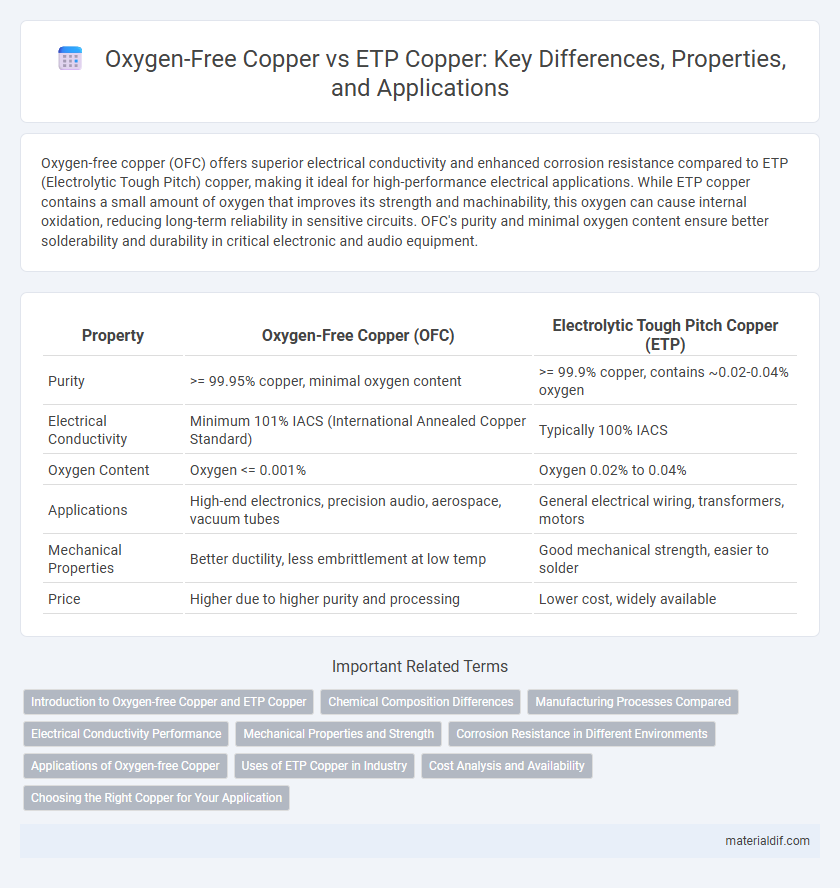Oxygen-free copper (OFC) offers superior electrical conductivity and enhanced corrosion resistance compared to ETP (Electrolytic Tough Pitch) copper, making it ideal for high-performance electrical applications. While ETP copper contains a small amount of oxygen that improves its strength and machinability, this oxygen can cause internal oxidation, reducing long-term reliability in sensitive circuits. OFC's purity and minimal oxygen content ensure better solderability and durability in critical electronic and audio equipment.
Table of Comparison
| Property | Oxygen-Free Copper (OFC) | Electrolytic Tough Pitch Copper (ETP) |
|---|---|---|
| Purity | >= 99.95% copper, minimal oxygen content | >= 99.9% copper, contains ~0.02-0.04% oxygen |
| Electrical Conductivity | Minimum 101% IACS (International Annealed Copper Standard) | Typically 100% IACS |
| Oxygen Content | Oxygen <= 0.001% | Oxygen 0.02% to 0.04% |
| Applications | High-end electronics, precision audio, aerospace, vacuum tubes | General electrical wiring, transformers, motors |
| Mechanical Properties | Better ductility, less embrittlement at low temp | Good mechanical strength, easier to solder |
| Price | Higher due to higher purity and processing | Lower cost, widely available |
Introduction to Oxygen-free Copper and ETP Copper
Oxygen-free copper (OFC) is a high-purity copper with oxygen content below 0.001%, offering superior electrical and thermal conductivity compared to standard copper grades. Electrolytic Tough Pitch (ETP) copper contains a small amount of oxygen, typically around 0.02% to 0.04%, which improves its mechanical strength but slightly reduces conductivity. OFC is ideal for high-end electrical applications requiring minimal signal loss, while ETP copper is commonly used in general electrical wiring and industrial components.
Chemical Composition Differences
Oxygen-free Copper (OFC) contains a minimum of 99.95% copper with oxygen levels below 0.001%, resulting in superior electrical conductivity and corrosion resistance. ETP Copper (Electrolytic Tough Pitch), typically 99.9% pure, includes oxygen content around 0.02% to 0.04%, which enhances its suitability for welding and brazing applications but reduces conductivity compared to OFC. The key chemical difference lies in the oxygen concentration, affecting the copper's physical properties and electrical performance.
Manufacturing Processes Compared
Oxygen-free copper (OFC) undergoes a specialized refining process that reduces oxygen content below 0.001%, typically involving vacuum melting or electrolysis, enhancing electrical conductivity and purity. ETP (Electrolytic Tough Pitch) copper is produced through an electrorefining process with a controlled oxygen level around 0.02%-0.04%, balancing conductivity and mechanical strength. The manufacturing distinction impacts applications, where OFC is preferred for critical electronic components requiring minimal oxygen-induced faults, while ETP copper suits general electrical wiring and industrial use.
Electrical Conductivity Performance
Oxygen-free copper (OFC) exhibits superior electrical conductivity compared to Electrolytic Tough Pitch (ETP) copper due to its high purity levels, typically exceeding 99.99% copper content. The absence of oxygen in OFC reduces the presence of oxides and impurities, which enhances electron mobility and lowers electrical resistance. ETP copper, containing trace oxygen levels around 0.02%, shows slightly lower conductivity, generally around 100% IACS (International Annealed Copper Standard), while OFC can achieve conductivity levels up to 101% IACS.
Mechanical Properties and Strength
Oxygen-free copper (OFC) exhibits superior mechanical properties and higher tensile strength compared to Electrolytic Tough Pitch (ETP) copper, due to its minimal oxygen content which reduces brittleness and improves ductility. ETP copper, containing around 0.02-0.04% oxygen, offers excellent electrical conductivity but moderate strength, making it suitable for general electrical applications. The enhanced purity of OFC results in better resistance to hydrogen embrittlement and improved thermal stability, critical for high-performance electronic and industrial uses.
Corrosion Resistance in Different Environments
Oxygen-free copper (OFC) exhibits superior corrosion resistance compared to Electrolytic Tough Pitch (ETP) copper, especially in chemically aggressive or high-purity applications. OFC's minimal oxygen content prevents the formation of copper oxides that can degrade material integrity in acidic or industrial environments. In contrast, ETP copper contains more oxygen, increasing susceptibility to internal oxidation and reducing durability under corrosive conditions.
Applications of Oxygen-free Copper
Oxygen-free copper (OFC) is highly valued in applications requiring superior electrical conductivity and thermal performance, such as in high-end audio cables, cryogenics, and vacuum or semiconductor manufacturing. Its minimal oxygen content reduces the risk of hydrogen embrittlement and enhances corrosion resistance, making it ideal for sensitive electronics and precision instruments. Unlike ETP copper, oxygen-free copper is preferred in environments where purity directly impacts the reliability and efficiency of the final product.
Uses of ETP Copper in Industry
ETP (Electrolytic Tough Pitch) copper is widely used in electrical wiring and electronics due to its excellent conductivity and cost-effectiveness. Its high purity and ductility make it ideal for manufacturing cables, bus bars, and electrical connectors in industrial applications. Industries like power generation, telecommunication, and automotive rely on ETP copper for efficient electrical performance and durability.
Cost Analysis and Availability
Oxygen-free copper (OFC) generally costs more than Electrolytic Tough Pitch (ETP) copper due to its higher purity and specialized refining process. ETP copper is more widely available and commonly used in electrical applications, making it a cost-effective choice for large-scale production. The balance between material cost and performance requirements often determines the selection between OFC's superior conductivity and ETP's accessibility.
Choosing the Right Copper for Your Application
Oxygen-free copper (OFC) offers higher electrical conductivity and superior corrosion resistance, making it ideal for sensitive electronic components and high-frequency applications. Electrolytic Tough Pitch (ETP) copper provides cost-effective performance with a slightly lower purity level, commonly used in general electrical wiring and industrial applications. Selecting the right copper depends on balancing conductivity requirements, environmental conditions, and budget constraints to ensure optimal performance and longevity.
Oxygen-free Copper vs ETP Copper Infographic

 materialdif.com
materialdif.com